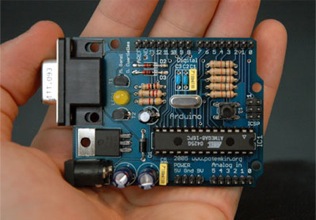Arduino is an open-source electronics prototyping platform based on flexible, easy-to-use hardware and software. It's intended for artists, designers, hobbyists, and anyone interested in creating interactive objects or environments.
Arduino can sense the environment by receiving input from a variety of sensors and can affect its surroundings by controlling lights, motors, and other actuators. The microcontroller on the board is programmed using the Arduino programming language(based on Wiring) and the Arduino development environment (based on Processing). Arduino projects can be stand-alone or they can communicate with software on running on a computer (e.g. Flash, Processing, MaxMSP).

The boards can be built by hand or purchasedpreassembled; the software can be downloaded for free. The hardware reference designs (CAD files) areavailable under an open-source license, you are free toadapt them to your needs.
Arduino received an Honorary Mention in the Digital Communities section of the 2006 Ars Electronica Prix. The Arduino team is: Massimo Banzi, David Cuartielles,Tom Igoe, Gianluca Martino, and David Mellis. Credits
Buy an Arduino Board
Download the Arduino Software
Development: For information on the development of Arduino, see the Arduino project on Google Code. Changes to the software are discussed on thedevelopers mailing list.
Elsewhere: You can find lots of pictures of Arduino projects and workshops in the Arduino tag on Flickr. Related links can be found on the Arduino tag on del.icio.us.
Getting Started
To get started, follow the instructions for your operating system: Windows, Mac OS X or Linux; or for your board:Arduino Nano, Arduino Mini, Arduino BT, LilyPad Arduino,XBee shield. If you're having trouble, check out thetroubleshooting suggestions.
Learning
Examples of how to work with the Arduino language and common electronic components; further readings on thefoundations; information on hacking and extending the Arduino hardware and software; external resources.
Reference
Reference for the Arduino language (see also theextended version); a collection of libraries for working with various types of hardware; a comparison with other prototyping platforms, and information about thecomponents of the Arduino board.
Hardware
Information about the Arduino hardware, including reference designs (EAGLE files).
Blog
General announcements and thoughts from the Arduino team can be found in our blog.
Forum
The multi-lingual forum is the place to go with questions of all kinds.
Playground (Wiki)
We're collecting Arduino knowledge, tutorials, and instructions in the playground wiki.









 14k flash program storage
14k flash program storage








